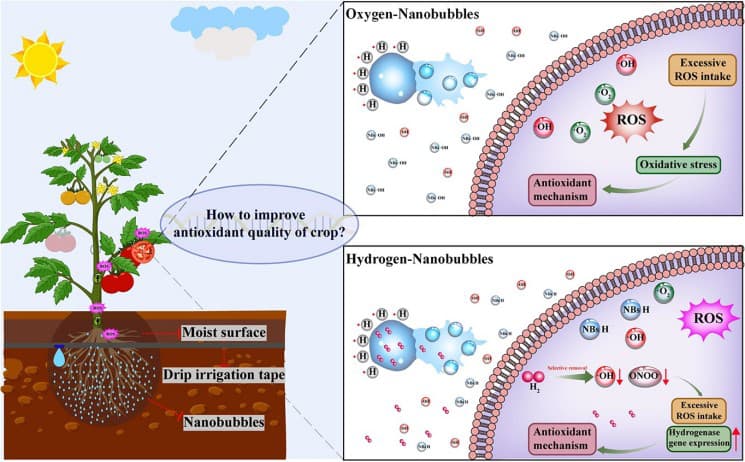Scientists use hydrogen nanobubbles to boost tomato antioxidants
A groundbreaking study reveals that hydrogen nanobubble irrigation can significantly enhance the antioxidant content of tomatoes, potentially revolutionising crop nutrition and agricultural practices. This technique not only fortifies the fruit with higher concentrations of health-boosting compounds but also provides a blueprint for leveraging hydrogen’s unique properties in agriculture.
Nanobubble technology unlocks hydrogen’s potential
The research, conducted by an international team of scientists, addresses long-standing challenges in utilising hydrogen’s antioxidant properties in agriculture. Traditionally, hydrogen’s low solubility and rapid diffusion have limited its agricultural applications. However, the integration of hydrogen with nanobubble technology offers a promising solution to these obstacles.

Conceptual figure explaining the impact of HNBs on the antioxidant quality of tomatoes. (i) ONBs may use the free radicals produced by bubble rupture to induce the antioxidant mechanism, and (ii) HNBs may promote the expression of genes, such as those encoding for hydrogenase, to increase the accumulation of natural antioxidants.
Subsurface drip irrigation yields impressive results
The study employed subsurface drip irrigation with hydrogen nanobubble water on tomato plants. This method resulted in a remarkable increase in key antioxidants, including:
- Lycopene
- Ascorbic acid
- Flavonoids
- Resveratrol
Compared to traditional groundwater irrigation, these antioxidants saw increases ranging from 16.3% to an astounding 264.8%.
Molecular mechanisms revealed
Through comprehensive transcriptomic and metabolomic analyses, the researchers uncovered the molecular mechanisms underlying these improvements. The hydrogen nanobubbles were found to:
- Modulate the electron transport chain
- Enhance expression of genes involved in non-enzymatic antioxidant biosynthesis
- Promote synthesis of essential metabolites
These effects collectively contributed to the higher antioxidant levels observed in the tomatoes.
Implications for agricultural productivity and crop resilience
Dr Yunkai Li, the study’s corresponding author, emphasised the broader implications of their findings: “Our research demonstrates the transformative potential of hydrogen nanobubble irrigation in agriculture. This method not only enhances the nutritional quality of tomatoes but also offers a sustainable solution to improve crop resilience and productivity.”
The innovative technique presents a promising avenue for addressing challenges in agricultural practices, potentially leading to:
- Improved crop quality
- Enhanced nutritional value of produce
- Increased agricultural productivity
- Greater crop resilience to environmental stresses
Future directions and optimisation
While the results are highly encouraging, further research is needed to optimise the application of hydrogen nanobubble irrigation across different crop types. Key areas for future investigation include:
- Determining optimal hydrogen requirements for various crops
- Establishing ideal irrigation frequencies
- Assessing long-term effects on soil health and ecosystem balance
Towards a healthier, more sustainable food system
The successful application of hydrogen nanobubble irrigation could have far-reaching consequences for both agriculture and public health. By significantly boosting the antioxidant content of crops, this method offers a sustainable approach to enhancing food quality and potentially improving consumer health outcomes.
As the global population continues to grow and climate change poses increasing challenges to agriculture, innovative techniques like hydrogen nanobubble irrigation may play a crucial role in ensuring food security and promoting healthier diets worldwide.
Reference:
Li, Y., et al. (2024). Enhancing tomato fruit antioxidant potential through hydrogen nanobubble irrigation. Horticulture Research. https://doi.org/10.1093/hr/uhae111



